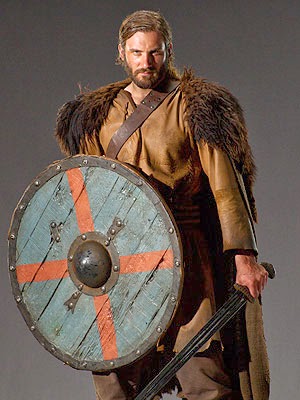The last few months I have been spending many hours on cracking my personal genealogy nightmare, riddled with so far three lines making me a cousin or niece of most all the Plantagenet family, majority of England and France’s royalty, with three different lines going back to the same house. I looked further and found the Viking warrior, Rollo. Jackpot! Rollo lived from c. 846 – c. 931 AD. His was one of two brothers of a Danish nobleman, or at that time Norseman. His brother was Gurim. Their father is historically unknown due to conflicting accounts. A quick search on wiki of Rollo has the following:
“Norwegian and Icelandic historians identified Rollo instead with Ganger Hrolf (Hrolf, the Walker), a son of Rognvald Eysteinsson, Earl of Møre, in Western Norway, based on medieval Norwegian and Icelandic sagas. The oldest source of this version is the Latin Historia Norvegiae, written in Norway at the end of the 12th century. This Hrolf fell foul of the Norwegian king, Harald Fairhair, and became a Jarl in Normandy. The nickname "the Walker", "Ganger" in Norse, came from being so big that no horse could carry him.”
In watching The History Channel’s TV show “Vikings,” Rollo does a lot of running away. But he is a great warrior, nonetheless. Being a man of questionable origin, he according to historical accounts was quite the raider. It is known that he had two wives. The first was more of a concubine, more than a wife, Poppa the daughter of Count Berenger. His second wife, Giselda, whom is discussed below. He raided and helped in a siege of Paris, down the river Siene in France. He is also the founder and first ruler of the Viking settlement what later became known as Normandy. He is also an ancestor of William the Conquer, and many of the kings of England and France.
In 911, Rollo pledged fidelity to Prince Charles, while he inhabited the lands in the region. He changed his name to a Frankish version, and converted to Christianity. It is noted that his name became Robert. In the Treaty of Saint-Clair-sur-Epte, drafted in 911 as well, Rollo was granted lands between Epte, the sea and parts of Brittany as apart of his allegiance to Charles. Also, sources state he also was given Giselda, the King’s daughter in marriage. Seemingly, this record of marriage is practically unknown to many Frankish sources. Rollo it is also argued among historians wither he was a duke as well, a position that would have been similar to Charles being a count at the time, yet had sworn allegiance too.
 |
| Charles the Simple giving his daughter to Rollo |
In 922, Charles was deposed by Robert I. Rollo took this change as a reason to break his allegiance and decided to move westward with more raids. With his raids came negotiations with French barons, which seemed to favor Rollo. With Rollo was granted lands of Le Mans and Bayeux. He then traveled on ward and continued with the seizure of Bessin in 924. The following year Rollo and his chieftains attacked Picardy. Rollo’s fellow Norseman stayed in the area and intermarried with the local people of the lands. Later they became known as “Normans” also having settled into the French Catholic culture of the land.
Rollo even though he had converted to Christianity under Charles, in the end succumbed to his roots of the beliefs of his homeland. Rollo died around 927, when it is noted that his fief in Normandy was passed to his son. Questioning, he might have lived a few years after that. Rollo’s grave is in the Cathedral at Rouen. It can be seen today.
Rollo on History channel’s “Vikings” is seen as a bit of a cowardly character. But the real Rollo was used just as a base. He didn’t have a brother named Rangar Lodbrok. Rangar if he actually lived, he is more of a legend if anything, but lived earlier than Rollo. His historical significance is difficult to pinpoint, as sources from this time are slim and limited. The real Rollo was defiantly a warrior and a very large contributor to some of the greatest medieval achievements and conquests that occurred in later centuries. He also is an ancestor of some of the most famous houses in England and France, particularly the houses of Bois, and Plantagenet. Perhaps the successes of these houses were because of Rollo’s seemingly impeccable warrior genes.
















